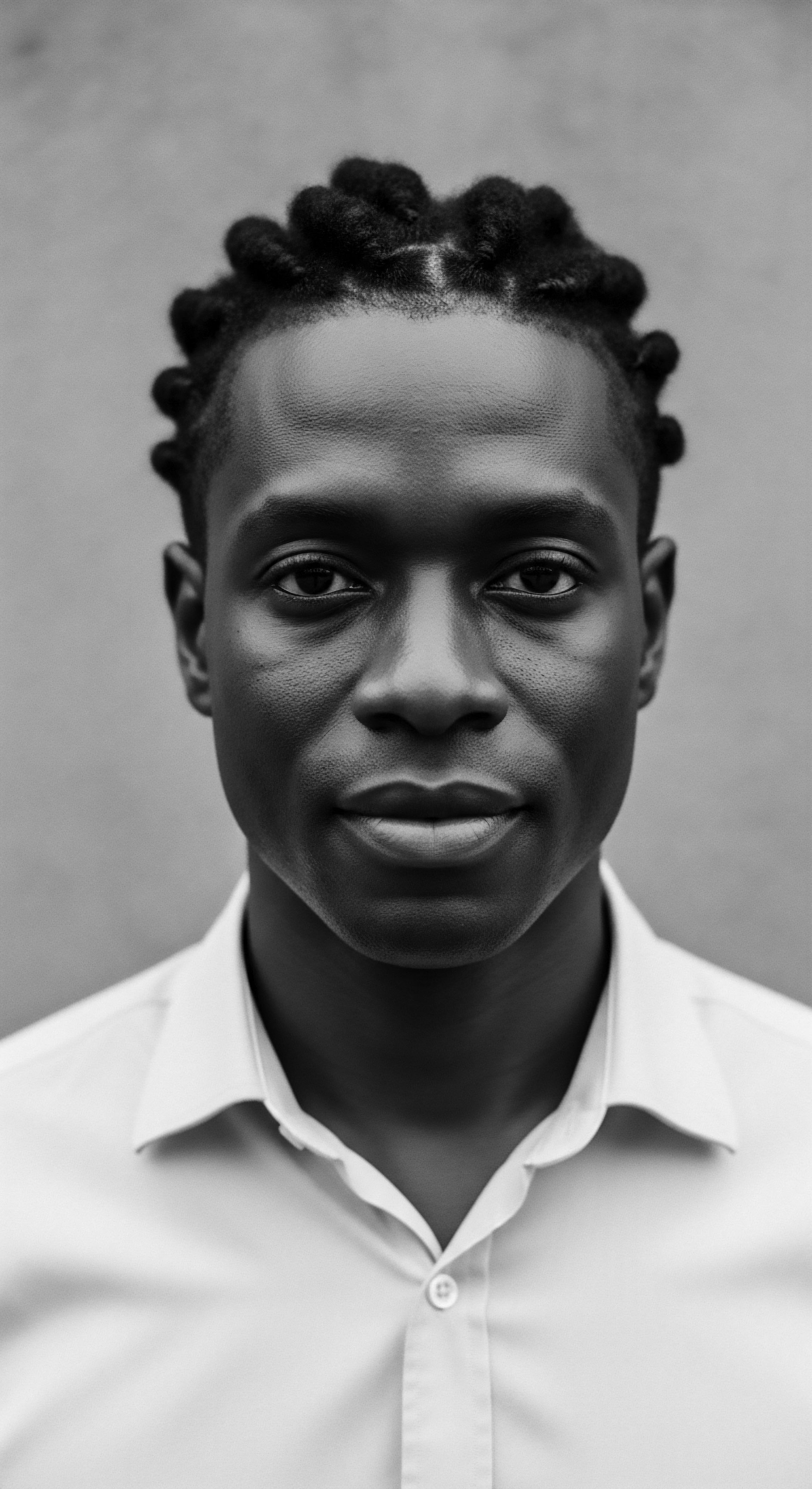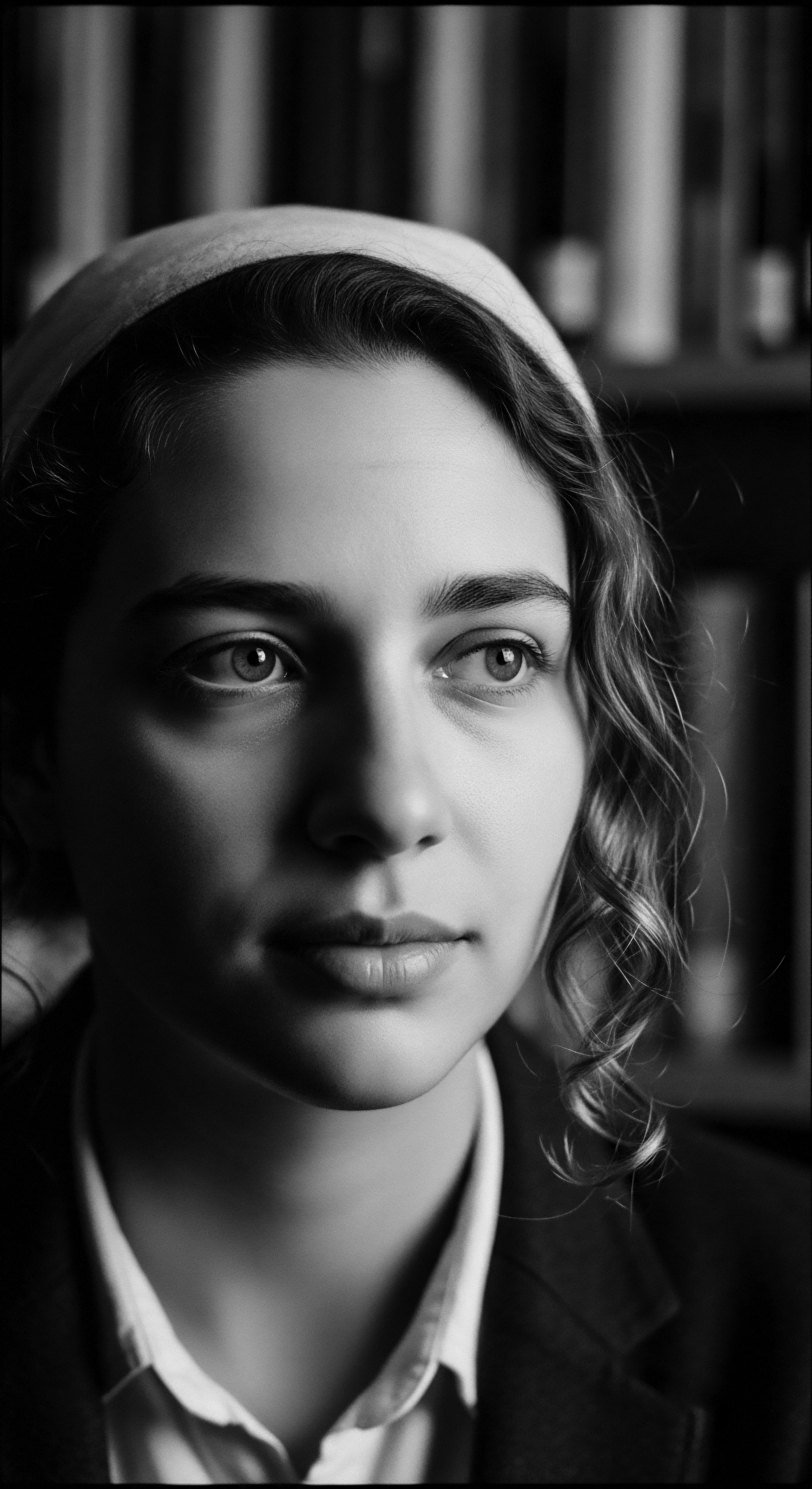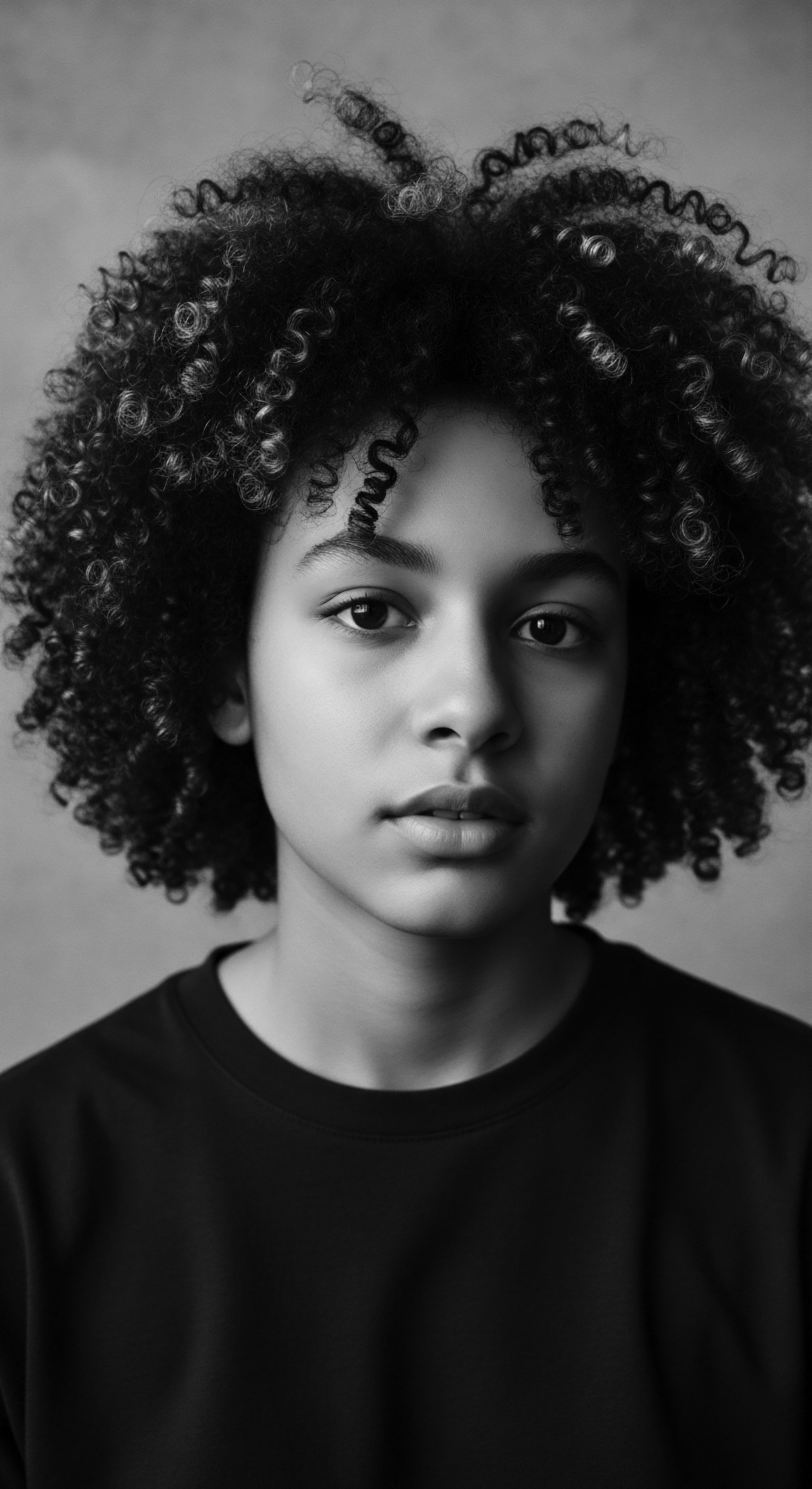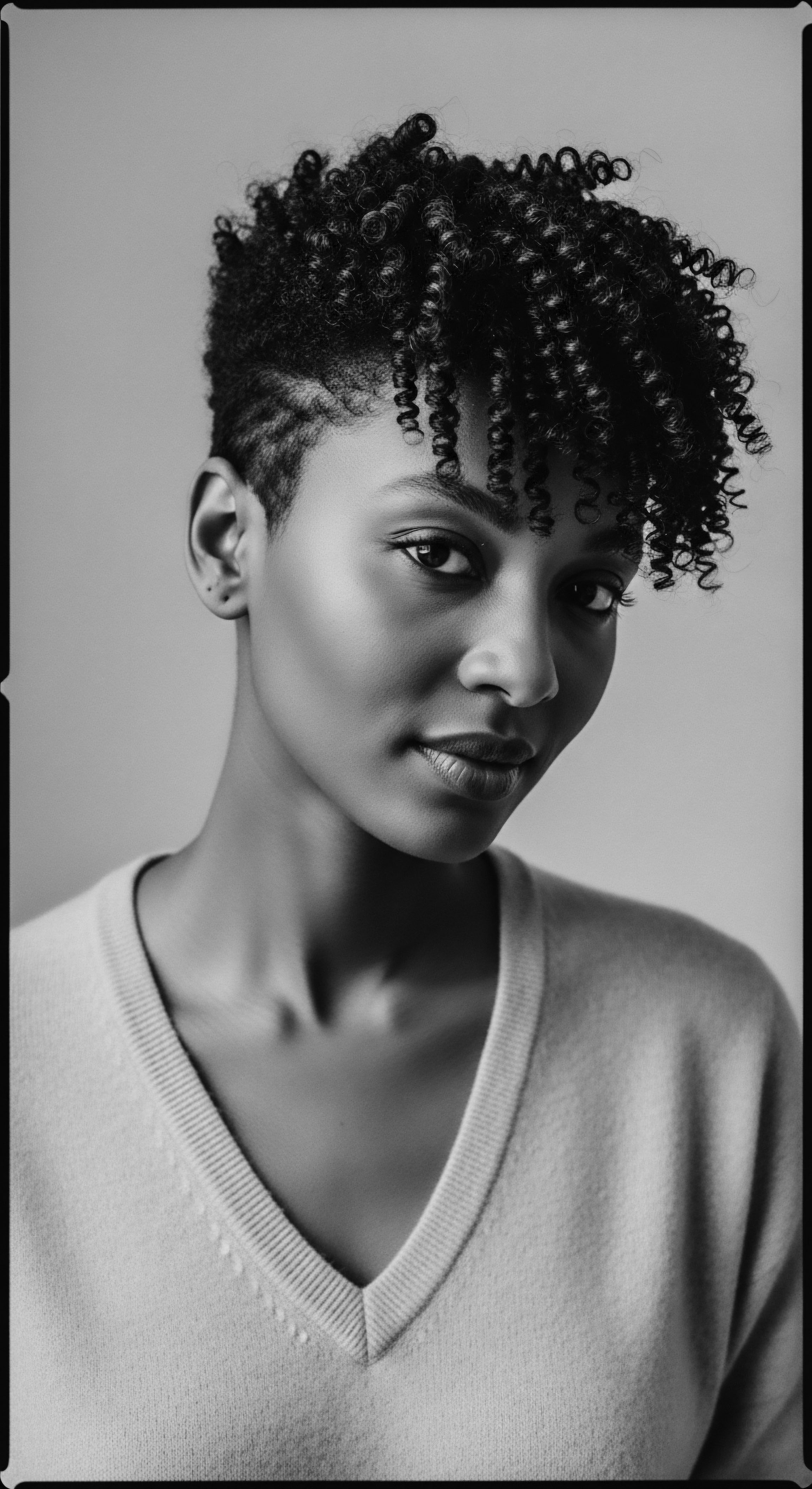
Roots
To gaze upon a single strand of textured hair is to gaze upon millennia of stories, each curl a testament to ancestral ingenuity, each coil a repository of wisdom passed through generations. We begin our quiet exploration at the very source, at the elemental blueprint that has guided ancestral coloring practices across continents, understanding how hair’s inner workings shaped the palettes of our forebears. The very existence of varied hair forms within humanity speaks to a profound biological inheritance, a symphony of adaptations etched into our physical being. For communities across the African diaspora, the hair on one’s head was not simply a biological covering; it was, and remains, a living archive, a scroll upon which histories, identities, and spiritual convictions were penned.

Hair’s Elemental Blueprint
The structure of textured hair – coils, curls, kinks, and waves – presents a unique surface for interaction with natural pigments. Unlike straight hair, which generally presents a smooth, cylindrical shaft, textured hair is often elliptically shaped, exhibiting twists and turns along its length. These structural differences affect everything from how light reflects off the strands to how external substances adhere or penetrate.
The outermost layer of each hair, the Cuticle, composed of overlapping scales, stands as the hair’s primary defense and also its gatekeeper. In textured hair, these cuticle scales tend to be more lifted or open, particularly at the curves of the coil, allowing for a different kind of engagement with external substances.
Beneath the cuticle lies the Cortex, the hair’s true heart, where melanin – the pigment responsible for hair’s natural color – resides. Melanin in textured hair often exhibits a more varied distribution within the cortex compared to straight hair. Eumelanin, responsible for black and brown tones, and pheomelanin, which lends reddish and yellow hues, commingle in diverse ratios, creating the spectrum of natural Black and mixed-race hair colors. This internal pigment composition is a foundational factor in how ancestral coloring practices achieved their desired effects.
When ancient peoples sought to adorn or transform their hair with the earth’s bounty, they were, perhaps unknowingly, engaging in a dialogue with this intrinsic chemistry and physical form. The success of a plant-based dye or mineral paste depended directly on its ability to bypass or adhere to the cuticle, then interact with the melanin within, or simply coat the outside for a temporary yet visible effect.
Hair’s inherent structure, from its coiled shape to its open cuticle scales, provided distinct opportunities and challenges for ancestral coloring practices.

Ancestral Lexicon and Hair’s Design
The way societies categorized and spoke about textured hair often stemmed from keen observation of these physical traits. While modern systems attempt to numerically classify curl patterns, ancestral communities often used descriptors rooted in lived experience, function, and cultural meaning. Hair was recognized by its ability to hold intricate shapes, its capacity for absorption, and its natural resilience.
These attributes were not abstract scientific concepts, but tangible qualities that informed daily care and ceremonial adornment. The application of coloring agents, whether for ritual, beautification, or protection, was deeply entwined with this practical understanding of hair’s inherent nature.
Consider the very act of preparing hair for coloring in ancient times. Without access to modern chemical processes, ancestral artisans understood that the hair’s surface had to be ready to receive color. Whether through cleansing with natural soaps made from plant ash or through conditioning with plant oils, these preparatory steps unknowingly manipulated the cuticle, making it more receptive to pigments. The way a specific plant dye was ground, mixed, and applied was a direct response to the hair’s texture.
A coarser powder might be better suited for coating tightly coiled strands, while a finer paste might be designed to cling to looser curls. This intricate choreography between hair structure and preparation speaks volumes about the depth of ancestral knowledge.

Growth Cycles and Environmental Dialogue
Hair’s cyclical growth pattern, from active growth (anagen) to resting (telogen) and shedding (exogen), was also observed by ancestral communities. While not understood in microscopic detail, the continuous renewal of hair meant that any coloring was a temporary act, requiring periodic reapplication. This inherent impermanence fostered a continuous engagement with hair care and aesthetic expression. Environmental factors also held sway.
The availability of specific plants for dyes, the presence of mineral deposits, or even the sun’s intensity, which could alter the longevity of natural colors, all played a part in shaping coloring practices. Ancestral communities, living in close attunement with their environments, selected materials that were not only effective but also sustainably sourced, reflecting a deep respect for the land that provided their coloring agents. The very strength and spring of textured hair, so often remarked upon today, was a physical manifestation of its survival through generations, a testament to its genetic and environmental legacy.
- Melanin’s Role ❉ The inherent pigments in textured hair determined the underlying tone upon which natural dyes would lay, influencing the final visible color.
- Cuticle Integrity ❉ The outermost layer’s structure, particularly its tendency to be more open, dictated the absorption or adherence of mineral and plant dyes.
- Coil Pattern ❉ The physical shape of the hair strand affected the application and retention of coloring pastes, often requiring different consistencies and methods.
This foundational understanding of hair, both seen and unseen, formed the initial palette upon which ancestral coloring practices were drawn. The ingenuity lay in recognizing how nature’s gifts could complement and transform these inherent qualities, creating a vibrant continuum of beauty and meaning across generations.

Ritual
Ancestral coloring practices were seldom isolated acts of adornment. They were often deeply woven into the fabric of daily life, into rites of passage, and into the very articulation of identity. The physicality of textured hair, its unique capacity for shaping and holding form, made it a canvas without equal, a living sculpture upon which cultural narratives were visibly etched. The application of color, therefore, transformed from a simple cosmetic step into a profound, often communal, ritual.

Protective Adornment and Ancestral Form
Many ancestral coloring traditions arose from a practical understanding of hair’s needs, particularly in diverse climates. In harsh, sun-drenched environments, hair protection was paramount. Here, the very structure of textured hair – its density, its ability to hold emollients – lent itself to protective applications that also imparted color. The Himba women of Namibia serve as a striking example of this intertwined function and heritage.
For centuries, they have coated their hair and skin with Otjize, a distinctive paste of red ochre, butterfat, and aromatic resin. This practice yields a rich, reddish hue, a visual signature of their identity. Beyond its aesthetic appeal, otjize provides a natural sunscreen, safeguarding hair and skin from the relentless desert sun and deterring insects. The tightly coiled, voluminous nature of Himba hair effectively holds this protective, pigmented coating, demonstrating a direct interplay between hair structure and the efficacy of an ancestral coloring practice that transcends mere visual appeal. The physical properties of ochre, particularly its iron oxide content, would interact with the hair’s surface, clinging to the slightly more lifted cuticles and porous areas of the coils, ensuring adherence and lasting color.

Natural Dyes and Techniques
The ingenuity of ancestral communities in sourcing and preparing natural dyes is a testament to their profound connection with the botanical world. The specific ways these dyes were processed and applied were often direct responses to the perceived interaction with textured hair. Roots, bark, leaves, and minerals were carefully selected for their pigment properties and their ability to be absorbed by or coat hair strands.
For instance, the use of certain plant materials, rich in tannins, would impart dark brown or black shades by interacting with the hair’s protein structure. The preparation might involve long soaking, grinding, or fermentation to release the color compounds, acknowledging the need for these natural agents to work slowly and gently with the hair’s inherent qualities.
The methods of application were equally attuned to textured hair’s nature. Unlike simply painting a smooth surface, coloring coiled hair involved intricate techniques to ensure even distribution and absorption. This might include sectioning, twisting, or braiding hair before applying the color, allowing for deeper saturation or the creation of specific patterns. The communal aspect of these practices was also significant.
Hair care, including coloring, often occurred within family or community settings, becoming a shared activity that reinforced social bonds and transmitted traditional knowledge from elder to youth. This collective engagement ensured the continuity of methods passed down through generations, each touch, each stroke, a reaffirmation of a shared heritage.
| Pigment Source Red Ochre (Hematite) |
| Derived Color Reds, Oranges, Browns |
| Interaction with Textured Hair Mineral particles adhere to lifted cuticles and porous areas of coils, providing both color and physical protection. |
| Pigment Source Indigofera Plants (Indigo) |
| Derived Color Blues, Violets (can create black tones with henna) |
| Interaction with Textured Hair Dye molecules bind to keratin through oxidative process; efficacy enhanced by hair's natural porosity. |
| Pigment Source Henna (Lawsonia inermis) |
| Derived Color Reds, Oranges, Browns |
| Interaction with Textured Hair Lawsone molecules stain keratin, particularly effective on hair with more open cuticle layers, common in textured hair. |
| Pigment Source Kola Nut (Cola acuminata) |
| Derived Color Dark Browns, Blacks |
| Interaction with Textured Hair Tannins react with proteins in the hair shaft, depositing a deep, rich color that can be particularly striking on darker hair. |
| Pigment Source These ancient coloring agents were chosen for their availability, efficacy, and symbolic value within specific community heritage. |

The Purpose Behind the Hue
Beyond the practical benefits, coloring hair was a powerful declaration of identity, status, and spiritual connection. A particular shade might signify marital status, age, or readiness for a new life stage. It could mark a warrior’s prowess, a leader’s wisdom, or a healer’s spiritual insight. The choices of color were not arbitrary; they were imbued with profound cultural meaning, reflecting a society’s values and beliefs.
The application of color, often accompanied by song, dance, or storytelling, served to reinforce these meanings, making the act a holistic experience for the individual and the community. The dense, pliable nature of textured hair allowed for these colors to be applied in ways that were not only visible but also sculptural, becoming an integral part of elaborate hairstyles that communicated complex social codes. The very act of preparing and applying these materials became a shared heritage, a tangible link to the wisdom of those who came before.
Ancestral hair coloring was a deliberate, layered practice, reflecting both hair’s biological responsiveness and profound cultural significance.
- Preparation Practices ❉ Cleansing with natural agents and conditioning with oils prepared the hair’s surface, making it more receptive to pigments.
- Application Techniques ❉ Sectioning, twisting, and braiding ensured uniform color distribution and allowed for intricate pattern creation specific to hair’s texture.
- Symbolic Meanings ❉ Colors often denoted social status, age, spiritual affiliations, or communal identity, transforming cosmetic acts into powerful statements.
This interplay of science, art, and spirit created a vibrant tapestry of ancestral coloring practices, each thread a testament to the intimate relationship between textured hair’s physical attributes and the living heritage of human expression.

Relay
The legacy of ancestral coloring practices for textured hair does not reside solely in the echoes of the past; it lives on, a continuous relay of knowledge and spirit across generations. Understanding how the structure of textured hair informed these practices offers a profound vantage point, connecting the elemental biology of the strand to the intricate dance of human culture and ingenuity. The mechanisms, often discovered through centuries of observation and trial, reveal a sophisticated engagement with natural chemistry, long before modern laboratories existed.

The Chemistry of Adornment
At the heart of how textured hair received ancestral colors lies the interaction between the pigment molecules and the hair’s complex protein structure. Textured hair, with its unique helical twists and varying porosity along the shaft, presents a distinct surface for dyes. Mineral pigments, such as ochre, primarily work by coating the hair shaft. The slightly lifted cuticle layers characteristic of many textured hair types provide more microscopic irregularities for these finely ground particles to adhere to.
This physical adhesion, sometimes reinforced by the natural oils or fats mixed with the pigment, created durable, protective layers that simultaneously imparted color. In warmer climates, this layered approach offered protection from solar radiation, a dual benefit deeply ingrained in many ancestral practices. Modern science, through electron microscopy, allows us to visualize this adherence, affirming the efficacy of techniques refined over millennia without such tools. The practice of applying red ochre to hair and body by the Himba people of Namibia exemplifies this.
This custom not only creates the distinctive reddish appearance for which they are known but also provides a practical shield against the desert’s harsh sun and a means of hygiene where water is scarce. The Ferric Oxide in red ochre, a naturally occurring mineral, bonds effectively with the keratinized proteins of textured hair, clinging to its unique topography. This centuries-old tradition, passed down through matriarchal lines, directly showcases how the hair’s structure—its coil, its density, its surface roughness—is intrinsically linked to the function and aesthetic outcome of the coloring practice. (Barnard, 1992)
Plant-based dyes, such as henna or indigo, operate through different chemical pathways. Henna, derived from the Lawsonia inermis plant, contains a molecule called lawsone. This molecule binds to the keratin protein in hair, staining it a reddish-orange hue. The porosity differences often seen in textured hair, where some areas of the strand may be more open to absorption, can influence how evenly henna distributes and how vibrant the final color appears.
Indigo, from the Indigofera genus, acts as a ‘direct dye’ or ‘oxidative dye’ depending on preparation. When used alone, it stains the outer layers of the hair blue; when used in combination with henna, it can create deeper brown to black shades. The effectiveness of these plant dyes on textured hair often depended on prolonged application times, sometimes hours, allowing the pigments to slowly penetrate the hair shaft, particularly through the more open cuticles that characterise many coiled strands. Ancestral wisdom understood that patience was a requirement for achieving rich, lasting color, a patience that mirrored the slow, steady process of nature itself.

The Science of Ancestral Care
The efficacy of ancestral coloring practices was also heavily influenced by the holistic care rituals that surrounded them. Pre-coloring treatments, though not understood in scientific terms, often prepared the hair in ways that improved pigment uptake or adhesion. Using natural oils, plant mucilages, or even specific types of clays could help to cleanse the hair, balance its pH, or create a more uniform surface for color application.
The application of oils and fats, as seen in the Himba’s otjize, served not only as a binding agent for pigments but also as a conditioner, sealing moisture into the hair strand and providing a protective barrier. This understanding of nourishing the hair while coloring it speaks to a deep, intuitive science of hair wellness.
Ancestral coloring practices were intricate dances between natural pigments and hair’s physical properties, revealing a profound, inherited scientific understanding.
The cyclical nature of these practices – the repeated application of ochre or plant dyes – meant that the hair was continuously interacting with these natural materials. This long-term engagement likely contributed to the overall health of the hair and scalp, with many natural pigments possessing antimicrobial or antifungal properties. The wisdom of these repeated applications, reinforcing color and protection, ensured that the hair remained a vibrant expression of cultural belonging and personal vitality.
This continuous interaction nurtured the hair, demonstrating that the pursuit of beauty was intertwined with sustained wellbeing, a testament to the ancestral view of hair as a living, breathing part of the self. The choice of specific ochres, for instance, by the San people, not only for their color but also for their texture and adherence properties, speaks to a meticulous, empirically-derived knowledge of materials science centuries ago.
The endurance of these practices through generations speaks to their profound efficacy, a testament to ancestral understanding of hair’s inherent structure. The techniques, passed down from elder to youth, represent a living library of knowledge where science and heritage are inseparably linked. This ongoing relay of wisdom continues to inspire contemporary approaches to hair care, reminding us that the deepest insights often stem from the most ancient connections to our natural world and our own bodies.
- Pigment Adhesion ❉ Mineral dyes like ochre physically bind to the rougher surface and lifted cuticles common in textured hair, providing durable color.
- Keratin Bonding ❉ Plant dyes like henna interact chemically with hair’s keratin, with varied porosity impacting color uptake and intensity.
- Protective Layers ❉ Many ancestral coloring mixtures, such as Himba otjize, offered both aesthetic and functional benefits, safeguarding hair and skin from environmental factors.

Reflection
The journey through textured hair’s structure and its profound influence on ancestral coloring practices reveals something enduring, something beyond the fleeting trends of contemporary adornment. It brings us to a quiet realization ❉ a strand of hair is never simply a strand. It is a conduit, a vessel, a tangible link to a heritage stretching back through the mists of time, carrying stories whispered by the wind and hues painted by the earth.
Each curl, each coil, holds not only the blueprint of our physical selves but also the indelible marks of ancestral wisdom. The very act of applying color, born from a deep intuitive understanding of how natural pigments interact with hair’s unique landscape, was a meditation on connection—connection to self, to community, and to the living world that sustained them.
In this living archive of hair, we discern the remarkable ingenuity of those who came before. They understood, without microscopes or chemical equations, that hair’s particular elasticity, its density, and its capacity to receive and hold color dictated how one might approach it. The ochre clinging to a Himba woman’s coil, the deep indigo staining the braids of West African royalty, the rich reds woven into ceremonial styles—all speak to a meticulous empirical science, a science born of observation and reverence.
These practices were not about conquering hair but collaborating with it, honoring its inherent nature. The care that went into grinding minerals, extracting plant essences, and patiently applying these elements was an act of profound respect, a conversation between humanity and the earth’s bounty.
Our appreciation for textured hair today gains immeasurable depth when viewed through this ancestral lens. The resilience of these traditions, their survival against immense historical tides, attests to the deep meaning they held. They remind us that hair has always been a powerful medium for self-expression, for marking identity, and for bearing witness to a people’s journey. As we stand at the crossroads of ancient wisdom and modern understanding, the echoes of ancestral coloring practices gently guide us.
They invite us to reconsider the origins of true beauty, not as a manufactured ideal, but as an organic unfolding of connection, creativity, and unbroken heritage. The soul of a strand, indeed, continues to whisper its ancient truths, inviting us to listen, learn, and carry forward its luminous legacy.

References
- Barnard, Alan. 1992. Hunters and Herders of Southern Africa ❉ A Comparative Ethnography of the Khoisan Peoples.
- Dauda, A. S. A. O. Oladipo, and O. O. Olaoye. 2012. Ethnopharmacological Survey of Some Antimicrobial Plants Used in African Traditional Medicine.
- Henshilwood, Christopher S. and Francesco d’Errico. 2011. A Cognitive and Cultural Evolution of Ochre Use in the Middle Stone Age.
- Sieber, Roy, and Frank Herreman, Editors. 2000. Hair in African Art and Culture. Museum for African Art.
- Wilkens, Lena. 2017. The Symbolic and Functional Exploitation of Ochre during the South African Middle Stone Age.
